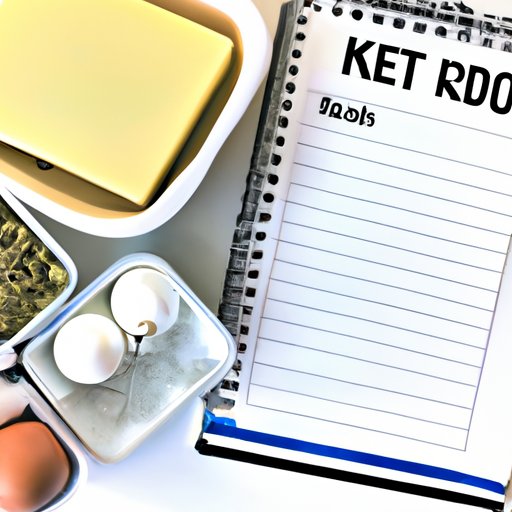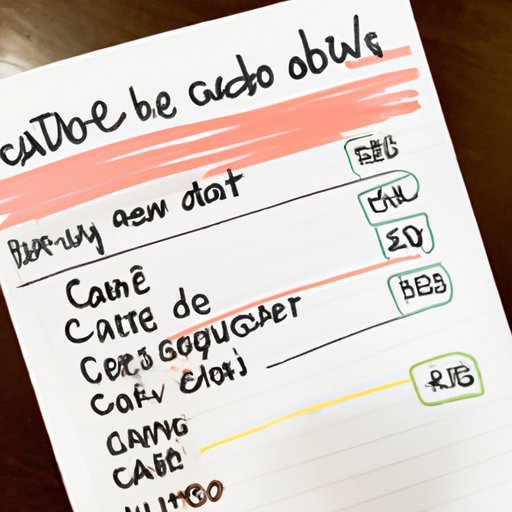
Introduction
Are you considering a keto diet? If so, you may be wondering how many carbs you can consume each day. A ketogenic diet involves consuming high amounts of healthy fat and minimal carbs to achieve ketosis, a state in which the body burns fat for fuel instead of carbs. However, it’s crucial to keep track of your carb intake to ensure that you stay in ketosis and reap the benefits.
The Ultimate Guide to Counting Carbs on a Keto Diet
Carbohydrates are one of the three macronutrients your body needs to function properly. They include sugars, starches, and fibers. When you consume carbs, your body breaks them down into glucose, which is used as fuel. On a keto diet, you need to limit your net carb intake to 20-50 grams per day to stay in ketosis. Net carbs are the total amount of carbs minus the fiber because fiber isn’t digested by your body and doesn’t count towards your carb limit.
To accurately track your net carb intake, you need to read nutrition labels and calculate the net carbs. The formula for calculating net carbs is simple: total carbs minus fiber equals net carbs.
Maximizing Your Weight Loss with Proper Carb Counting
Reducing your carb intake can be an effective way to lose weight, especially if you’re consuming more carbs than your body needs. However, it’s crucial to reduce carb intake without sacrificing taste and nutrition. You can do this by choosing foods that are low in carbs but high in healthy fats and protein, such as avocados, nuts, and seeds.
Tracking your carb intake is also essential for proper weight management. It allows you to identify the foods that are causing you to go over your carb limit and adjust your diet accordingly. Keeping a food diary can help you keep track of your carb intake and identify your problem areas.
Carb Counting Tips for Keto Beginners
Counting carbs may seem difficult at first, especially if you’re new to the keto diet. However, there are several tips and tricks that can help you accurately track your carb intake and avoid common mistakes. For example, you can plan your meals in advance and make sure that you’re eating low-carb foods that meet your daily limit.
You should also be cautious of hidden carbs in processed and packaged foods. Many of these foods are marketed as low-carb or keto-friendly but still contain significant amounts of carbs. Always read the nutrition label and calculate the net carbs before consuming anything.
How to Calculate and Track Your Daily Carb Intake on a Keto Diet
Tracking your daily carb intake is crucial for success on a keto diet. There are many tools and resources available to help you calculate and track your carb intake, such as smartphone apps like MyFitnessPal and Carb Manager. These apps can help you scan barcodes and add foods to your daily log for easy tracking.
You can also keep a food diary, which allows you to track your carb intake and identify problem areas. Make sure to measure your portions and record your carb intake accurately to get the most benefit.
The Importance of Understanding Net Carbs on a Keto Diet
Net carbs are the total amount of carbs minus the fiber. Tracking net carbs instead of total carbs is important on a keto diet because fiber isn’t digested and doesn’t count towards your carb limit. When you’re grocery shopping or eating out, always look for the net carb count on the nutrition label to make informed choices.
Calculating net carbs is easy, and it allows you to include more high-fiber foods in your diet without going over your limit. You can also prioritize low-carb foods that are high in fiber, such as leafy greens and cruciferous vegetables.

Navigating Carb Counts While Dining Out on a Keto Diet
Dining out can be challenging when you’re following a keto diet because many restaurant dishes are high in carbs. However, with a little research and planning, you can still enjoy dining out while keeping your carb intake in check.
Look up the nutritional information for your favorite restaurants and fast food chains ahead of time. Many restaurants and chains have their nutritional information available online or in their mobile apps. When dining out, look for keto-friendly options on the menu, such as grilled meats, salads, and low-carb sides.
Common Keto-Friendly Foods with Low Carb Counts to Include in Your Diet
There are many keto-friendly foods that are low in carbs and high in healthy fats, such as avocado, olive oil, and nuts. Incorporating these foods into your daily meal plan can help you stay in ketosis and meet your nutritional needs.
You can make these keto-friendly foods more appealing and tasty by incorporating them into your favorite recipes. For example, you can use almond flour instead of regular flour to make low-carb baked goods or use zucchini noodles instead of regular pasta.
Conclusion
Counting carbs is a crucial part of the keto diet. By reducing your carb intake and tracking your net carb intake, you can achieve ketosis and enjoy the benefits of the keto diet, such as weight loss and improved energy levels. Always make sure to read nutrition labels, avoid hidden carbs, and choose keto-friendly foods that are low in carbs and high in healthy fats. With these tips and tricks, you can continue your keto journey with confidence and success.




